The AMD Ryzen 9 3950X Review: 16 Cores on 7nm with PCIe 4.0
by Dr. Ian Cutress on November 14, 2019 9:00 AM ESTGoing For Power: Is 105W TDP Accurate?
For regular readers, we have covered the discrepancy in how different companies ascribe the Thermal Design Power to their product lines:
- Aligning Turbo with AMD’s Frequency Metrics
- Data in our Ryzen 2700X Review
- Talking TDP, Turbo and Overclocking with Intel Fellow Guy Therien
- TDP and Turbo Explained
- The Lynnfield Followup: Turbo Mode and Overclocking Investigated
While Intel’s TDP represents the internal power measured for long and sustained high performance (also motherboard dependent), AMD’s metric is more akin to actual thermal cooling requirements for a given cooler rating. That being said, the power consumption of AMD’s first and second generation Ryzen processors has often been parallel to the TDP rating on the box, with the CPU levelling out to the TDP value as we load up the cores with a high energy workload.
For example, here’s our 16-core 1950X data. The Threadripper 1950X is a 180 W chip, and we saw the cores take a total of 134 W.
Here’s our Ryzen 7 2700X data.
This 105 W TDP processor was only recording 86W across the cores at full load.
It’s worth noting that our data is primarily to do with the total power consumed by the cores. There are other power factors at play, such as the Infinity Fabric, the DRAM controller, the PCIe controller, and any other IO, which might add up to the power of the overall package. The maximum power available to a processor should be the package, of which the cores take up most of the sum.
With Ryzen 3000 and Zen 2, AMD’s attachment to TDP was not as clinical as its first two generations of hardware. In our Ryzen 7 3700X review, with the 12-core processor, we saw this:
The Ryzen 7 3700X is a 65 W processor, and yet we can see that the cores total up to 74 W by themselves, with the rest of the chip taking another 16W or so, totalling 90 W for the whole chip. This aligns with AMD's 'PPT', the maximum power that can be supplied to the socket, which is around 88W. This is perhaps indicative of two things: firstly, that Intel’s turbo policy was creating 95 W TDP chips that consumed 160W in turbo modes and AMD believed it had headroom, or pushing these new chips to the edge required a little more power.
With the Ryzen 9 3900X, with 12 cores, we saw the same thing again.
Despite this being a 105 W TDP chip, the cores at full load saw 122 W peak, with the rest of the chip getting ~24 W, making for an overall 146 W power draw (as measured by the processor internally). PPT for this chip is meant to be 142W.
This shows that Zen 2 has a different strategy to the previous Zen chips when it comes to how AMD is mixing the difference between TDP and PPT. If we saw the same thing with the Ryzen 9 3950X, then it pretty much confirms the hypothesis.
At its peak, the 3950X draws 137 W for the cores when 10 cores are loaded. The chip as a whole hits ~144-145W at that level, well above the 105 W TDP rating on the box and bang on the 142W PPT. This is partly why AMD is recommending a large liquid cooler for this chip. Under Intel’s definition, the TDP rating is a guarantee for the power consumption at base frequency, although most Intel processors can go above that frequency and stay within the power. We might be seeing something similar here with AMD now.
It is worth noticing that when up to two cores are loaded, we see each core getting around 18 W of power, but when all the cores are loaded, we are seeing between 6.9 W and 7.6 W. This is compared to the 12-core 3900X, which has about 17.5 W per core initially, and falls down to 10 W per core. AMD is trying to get a higher single core frequency from the 16-core hardware, so by giving more power when a single core is loaded, this might help.
One other thing to note is where the peak power is observed. We kind of already saw this on the Ryzen 9 3900X in that review, where the peak power of the chip happened when 10 cores were loaded, not the full 12 cores. The difference between the two was minimal, but we’re seeing this on a larger scale with the Ryzen 9 3950X.
When looking at both the cores-only power and the CPU total power, we get a peak with this processor when 10 cores are loaded. This would indicate a 3+2+3+2 mix on the CCXes, which is perhaps an inflection point when current densities start getting much higher and per-core power has to be reduced to ensure everything is still working optimally. The power differential between 10-core use and 16-core use is almost 20W, so users that don’t always use all the cores all the time might exhibit good per-thread performance up to 10 core workloads.
Speaking of frequencies, this has been a touchy topic of late. We have seen with recent news and testing that some users are not observing peak single core frequencies of their Ryzen processors. As we explained in our deep dive of the issue, part of it comes down to the fact that AMD’s turbo policies for Zen 2 are different to Intel: only one core in a set is likely to turbo up to the highest frequency, whereas Intel’s Turbo Boost 2.0 mandates that all cores should hit peak turbo. The other part of it is the testing methodology, but also the fact that the ACPI standards at the OS level can indicate a turbo on a shorter time scale than software can record, ultimately giving users a smeared out version of that turbo value. Then there are other things, like BIOS versions and Windows power plans.
With our Ryzen 9 3950X, the on-the-box single core turbo frequency is listed as 4.7 GHz. We tested using the ASRock X570 Taichi motherboard, a very high-end product, using Windows 10 v1909 on AGESA 1004B, on both the High Performance (HP) power plan and the Ryzen High Performance (RHP) power plan. For peak single core frequencies, we were able to see 4525 MHz on the HP plan, and 4650 MHz on the RHP plan. This latter value is pretty much on the button for the on-the-box turbo value (I’m sure some people will disagree about those 50 MHz).
These values on the RHP power plan were very instantaneous, as when we put a consistent single thread load on the core, the frequencies very quickly came down.
On the Ryzen High Performance power plan, our sustained single core frequency dropped to 4450 MHz. In these tests, we use an affinity mask to limit how many cores are active while we run POV-Ray, and take the reading about 30 seconds into the benchmark, which allows a core to experience a form of heat soak and reach a reliable current density. This is also how we reached the 18 W per core value for 1-2 core loading in the graphs above, indicating that in order to get a sustained 4.7 GHz single core frequency, AMD would need to drive around 21-24W to the core in order to get that value. It is very likely that the CPU can hit those high numbers, for microseconds at a time, as per the ACPI/CPPC2 stack, but for any user doing per-second or per 100ms monitoring, they’re not likely to see it.
Within this frequency graph though, we can see that the frequency beyond 3 cores has segments. Between 3 cores and 8 cores loaded, we get 4225 MHz to 4125 MHz (100 MHz range), and even at all cores loaded, we’re seeing 3875 MHz, well above the 3500 MHz base frequency listed on the box.
In our full review, we are testing the Ryzen 9 3950X on both the HP and RHP power plans.


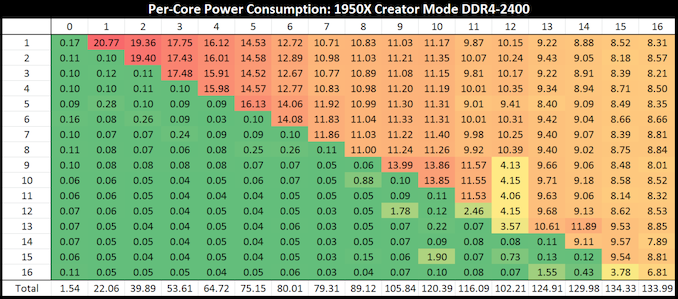

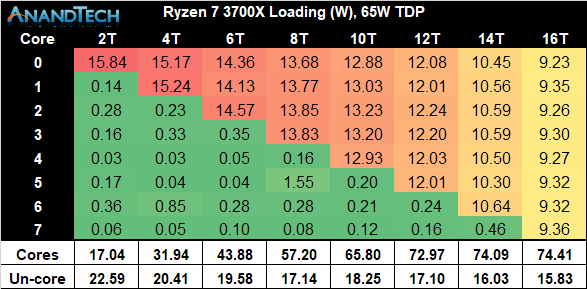
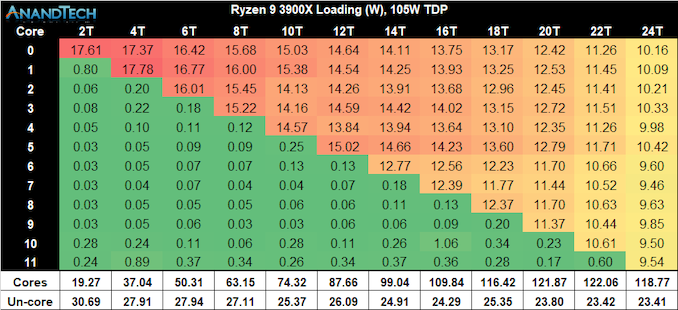
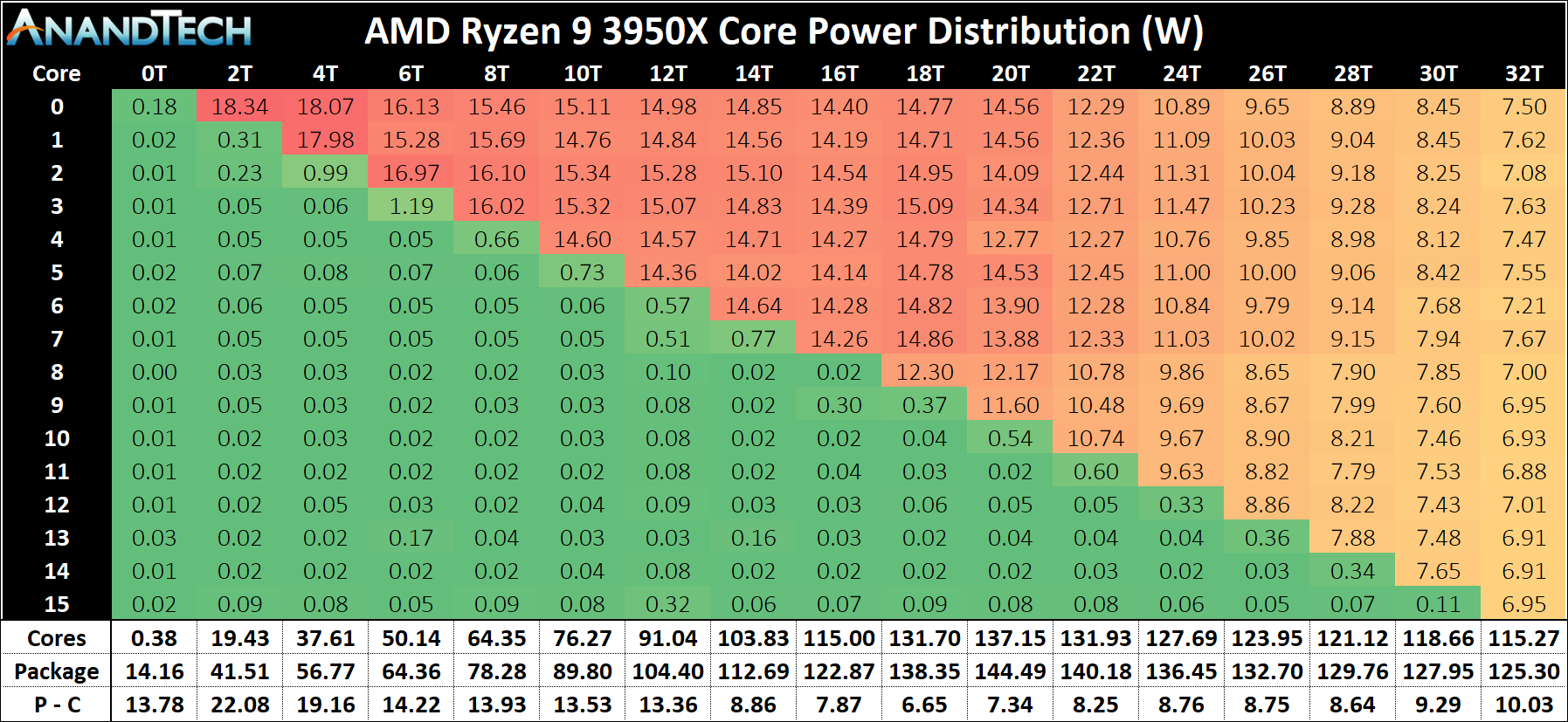
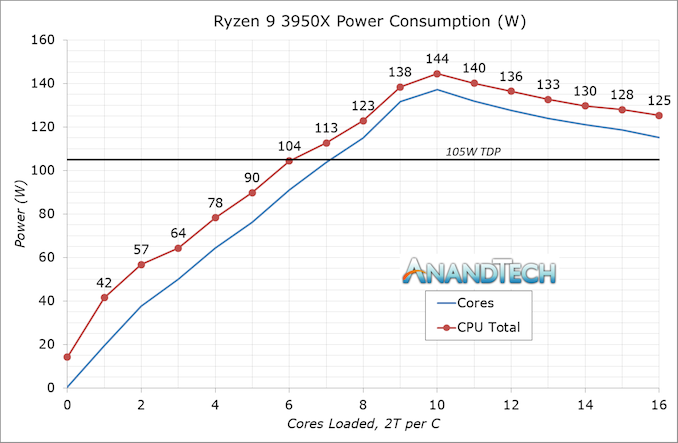
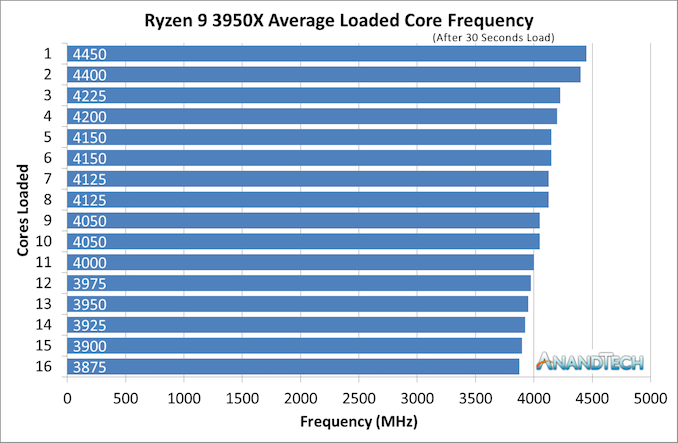








206 Comments
View All Comments
Devo2007 - Thursday, November 14, 2019 - link
First page "As we move into 2019" - should be "As we move into 2020"plp1980 - Thursday, November 14, 2019 - link
Is says as we move "through" not as we move "into"Ryan Smith - Thursday, November 14, 2019 - link
It did originally say "into". We've since fixed it.=)Netmsm - Friday, November 15, 2019 - link
Ryan, why isn't there any Cinebench test?!TheJian - Wednesday, November 20, 2019 - link
Because nobody uses it as Intel said (nobody is 1% or less right?)? Nobody making money is using something that is far slower that PAID products. Pointless to benchmark this in every review, just like it's pointless to test 4k in all vid card reviews when nobody is using that either (ok, nobody here means less than 2%...LOL). Whatever. Surely Ryan is chomping at the bit now to tell me 4k is the new enthusiast standard...LOL. Yeah, wake me when 1440p is, as it still isn't LONG after you said that at 660ti article. Still not even 5% years later, heck, both added up don't hit 7% last I checked (month ago?). 1080p however? 65% of users of 130mil steam gamers (this is pretty accurate for the world elsewhere no doubt). Should test LOADS of 1080p games, and maybe benchmark 1/2 at 1440p, only 1-2 at 4k if at all (should be done once a year or in a separate review of 4k yearly?). Until people use it, quit wasting time.Anandtech (and many others) seem to do a lot of testing that is NOT how a user would do use their PC. Handbrake crap quality etc. Who uses FAST? FASTER? You blind already so blur doesn't matter? Cinebench freeware same story. Intel seems to have a point though they didn't mind before losing massively on all these things they are now whining about.
https://store.steampowered.com/hwsurvey/Steam-Hard...
Yep, still right, not even 5% yet for 1440p, 7% accurate total 4k+1440p still...LOL. Keep dreaming ryan ;)
Netmsm - Sunday, November 24, 2019 - link
impertinent words! These are not the answer.Everybody who works on editing films knows how helpful the Cinebench tests are in specifying which CPU will be faster.
alysdexia - Thursday, November 28, 2019 - link
shall be swifterpeevee - Monday, November 25, 2019 - link
"Anandtech (and many others) seem to do a lot of testing that is NOT how a user would do use their PC."Absolutely. And all their tests get the same amount of space. Including those nobody can use or reproduce. BS all the time, like off-screen rendering, compute on Dolphin emulator, in-house 3DPM... Ancient codecs, irrelevant settings... Somebody needs to bring them back into reality.
Ian Cutress - Tuesday, March 24, 2020 - link
There is. It's in our benchmark database. www.anandtech.com/benchasking - Sunday, July 5, 2020 - link
@Ian Cutress there is significant doubt (in the form of harrasement) being expressed on the forums about your conclusion on page two of this article that the power consumption of Ryzen chips changed (went upward) between Zen+ and Zen 2. Would be interesting to see your further thoughts: https://forums.anandtech.com/threads/will-cpu-supp...